SPACE
Solar storms could cause more auroras
By AFP
July 30, 2024
In May, the most powerful geomagnetic storm to strike Earth in more than two decades lit up night skies in many parts of the world
Daniel Lawler
Massive explosions on the Sun have triggered warnings of geomagnetic storms that could create dazzling auroras in the northern United States, Europe and southern Australia from Tuesday night.
In May, the most powerful geomagnetic storm to strike Earth in more than two decades lit up night skies with colourful displays in Hawaii, Spain, South Africa and other places far from the extreme latitudes where they are normally seen.
“We’ve seen several large coronal mass ejections — plasma and other material from the sun’s surface shooting out into space,” Mike Bettwy, operations chief of the US-based Space Weather Prediction Center (SWPC), told AFP on Tuesday.
“As a result, the potential for space weather has ramped up significantly,” he said.
The coronal mass ejections (CMEs) are expected to arrive from Tuesday to Thursday, with “geomagnetic storm watches” declared on those days.
But “the brunt of the activity is most likely” to come on Tuesday, when there is a “strong” geomagnetic storm warning of G3 on the US National Oceanic and Atmospheric Administration scale, the SWPC said.
May’s record storms were classified as the most extreme level of G5. This means any potential auroras this week are unlikely to stray as far, or be as powerful, as those seen earlier this year.
But if the current forecast is correct, during the late evening hours in the United States on Tuesday, an “aurora could become visible as far south as the northeast US through the upper Midwest and across the rest of the northern states to include northern Oregon.”
The aurora borealis — also known as the northern lights — may become visible in Scotland over the next three nights, but could be “impeded by limited hours of darkness”, the UK’s Met Office said Tuesday.
“With a bit of luck,” auroras could also be spotted in northern Germany, the Netherlands and Belgium, according to the website SpaceWeatherLive.
Aurora australis — the southern lights — could be visible in the south of the Australian state of Tasmania and similar latitudes, the Met Office said.
– ‘Cannibal CME’ –
For those living in the right latitudes, auroras would be most visible away from city lights, in the darkest skies possible, before the Moon rises, Bettwy said.
People should use their cameras or phones to look, because today’s digital imagery can often pick them up even when the naked eye cannot, he added.
When CMEs erupt, they shoot around a billion tons of plasma — with an accompanying magnetic field — from the Sun toward the Earth.
One of the CMEs coming towards Earth this week merged with another, forming what is called a “Cannibal CME”, according to spaceweather.com.
The NOAA warned that more CMEs are continuing to erupt, so more could be coming.
When the CMEs slam into Earth’s magnetosphere, they can create geomagnetic storms.
The storms can mess with satellites orbiting Earth and affect things like radio signals and GPS positioning systems.
They can also knock out electricity grids — the “Halloween Storms” of October 2003 sparked blackouts in Sweden and damaged power infrastructure in South Africa.
Astronauts on the International Space Station often shelter during extreme solar activity to avoid being exposed to radiation.
Numerous strong solar flares — huge explosions on the Sun’s surface which can cause CMEs — have also been emitted in recent days.
Most CMEs and flares come from sunspots, which are massive, darker areas of intense activity on the solar surface. The sunspot cluster that caused May’s storms was 17 times the size of Earth.
As of Tuesday, there are 11 sunspots on the disc of the Sun, according to the Met Office in Britain.
More geomagnetic storms could be yet to come, because solar activity is only just approaching the peak of its roughly 11-year cycle.
The peak, called “solar maximum”, is expected between late 2024 and early 2026.
Two meteor showers will flash across the sky around the same time in late July
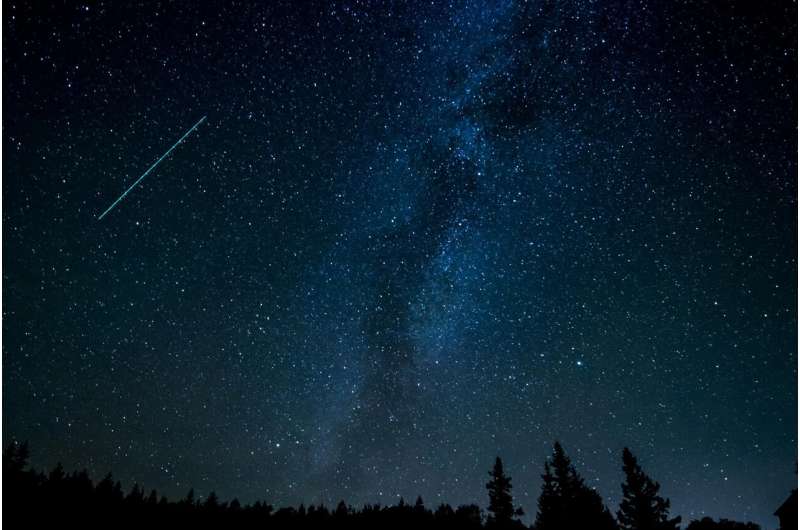
Get ready for a meteor shower doubleheader.
The Southern Delta Aquariid meteor shower peaks in late July. And this year, it will coincide with a second smaller meteor shower, the Alpha Capricornids.
The Delta Aquariids occur every year in North America's late summer. This year's peak activity happens early Tuesday morning, with an expected 15 to 20 meteors visible per hour in the Northern Hemisphere, under dark skies. Viewing should be even better in the Southern Hemisphere. The shower lasts through August 21, according to the American Meteor Society.
Around the same time, the Alpha Capricornid meteor shower should produce around five meteors per hour and lasts through August 15.
Here's what to know about the Delta Aquariids and other meteor showers.
What is a meteor shower?
Multiple meteor showers occur annually and you don't need special equipment to see them.
Most meteor showers originate from the debris of comets. The source of the Delta Aquariids is thought to be from the comet 96P/Machholz. The Alpha Capricornids originate from the comet 169P/NEAT.
When rocks from space enter Earth's atmosphere, the resistance from the air makes them very hot. This causes the air to glow around them and briefly leaves a fiery tail behind them—the end of a "shooting star."
The glowing pockets of air around fast-moving space rocks, ranging from the size of a dust particle to a boulder, may be visible in the night sky.
These two meteor showers are not high volume, but the Alpha Capricornids often produces very bright meteors, said University of Warwick astronomer Don Pollacco.
For skygazers, "one bright one is worth 20 faint ones," he said.
How to view a meteor shower
Meteor showers are usually most visible between midnight and predawn hours.
It's easier to see shooting stars under dark skies, away from city lights. Meteor showers also appear brightest on cloudless nights when the moon wanes smallest.
And your eyes will better adapted to seeing meteors if you aren't checking your phone. "It ruins your night vision," said NASA's Bill Cooke.
The Southern Hemisphere will have the best view of Delta Aquariids. Coinciding with a waning moon around 30% full means the clearest viewing will happen after midnight.
When is the next meteor shower?
The meteor society keeps an updated list of upcoming large meteor showers, including the peak viewing days and moonlight conditions.
The next major meteor shower will be the Perseids, peaking in mid-August.
© 2024 The Associated Press. All rights reserved. This material may not be published, broadcast, rewritten or redistributed without permission.
The Conversation
July 29, 2024

Humans on another Planet (Shutterstock)
When considering human settlements on the Moon, Mars and further afield, much attention is given to the travel times, food and radiation risk. We’ll undoubtedly face a harsh environment in deep space and some thinkers have been pointing to genome editing as a way to ensure that humans can tolerate the severe conditions as they venture further into the solar system.
In January, I was fortunate to attend a much-anticipated debate between astronomer royal Lord Martin Rees and Mars exploration advocate Dr Robert Zubrin. The event at the British Interplanetary Society took on the topic of whether the exploration of Mars should be human or robotic.
In a recent book called The End of Astronauts, Lord Rees and co-author Donald Goldsmith outline the benefits of exploration of the solar system using robotic spacecraft and vehicles, without the expense and risk of sending humans along for the ride. Dr Zubrin supports human exploration. Where there was some agreement was over Rees’s advocacy of using gene editing technology to enable humans to overcome the immense challenges of becoming an interplanetary species.
The video player is currently playing an ad. You can skip the ad in 5 sec with a mouse or keyboard
Our genome is all the DNA present in our cells. Since 2011, we have been able to easily and accurately edit genomes. First came a molecular tool called Crispr-Cas9, which today can be used in a high school lab for very little cost and has even been used on the International Space Station. Then came techniques called base and prime editing, through which miniscule changes can be made in the genome of any living organism.
The potential applications of gene editing for allowing us to travel further are almost limitless. One of the most problematic hazards astronauts will encounter in deep space is a higher dosage of radiation, which can cause havoc with many processes in the body and increase the longer-term risk of cancer.
Perhaps, using genome editing, we could insert genes into humans from plants and bacteria that are able to clean up radiation in the event of radioactive waste spills and nuclear fallout. It sounds like science fiction, but eminent thinkers such as Lord Rees believe this is key to our advancement across the solar system.
Identifying and then inserting genes into humans that slow down aging and counter cellular breakdown could also help. We could also engineer crops that resist the effects of exposure to radioactivity as crews will need to grow their own food. We could also personalise medicine to an astronaut’s needs based on their particular genetic makeup.
Imagine a future where the human genome is so well understood it has become pliable under this new, personalised medicine.
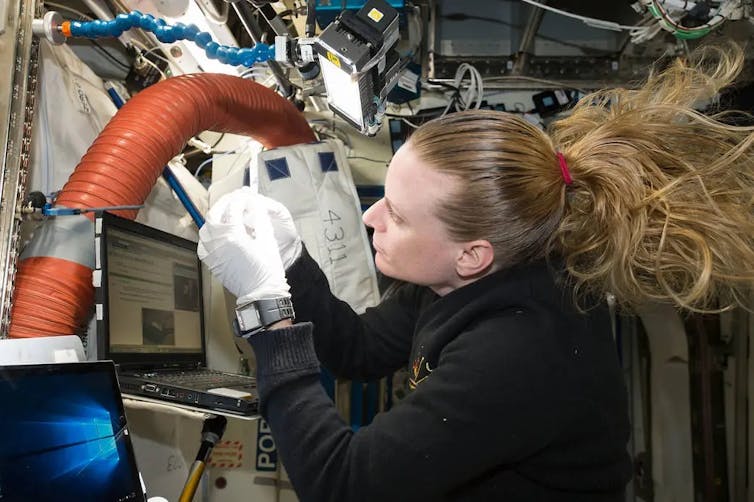
Kate Rubins was the first person to sequence DNA in space. NASA
Genes for extremes
Tardigrades are microscopic animals sometimes referred to as “water bears”. Experiments have shown that these tiny creatures can tolerate extreme temperatures, pressures, high radiation and starvation. They can even tolerate the vacuum of space.
Geneticists are eager to understand their genomes and a paper published in Nature sought to uncover the key genes and proteins that give the miniature creatures this extraordinary stress tolerance. If we could insert some of the genes involved into crops, could we make them tolerant to the highest levels of radiation and environmental stress? It’s worth exploring.
Even more intriguing is whether inserting tardigrade genes into our own genome could make us more resilient to the harsh conditions in space. Scientists have already shown that human cells in the lab developed increased tolerance to X-ray radiation when tardigrade genes were inserted into them.
Transferring genes from tardigrades is just one speculative example of how we might be able engineer humans and crops to be more suited to space travel.
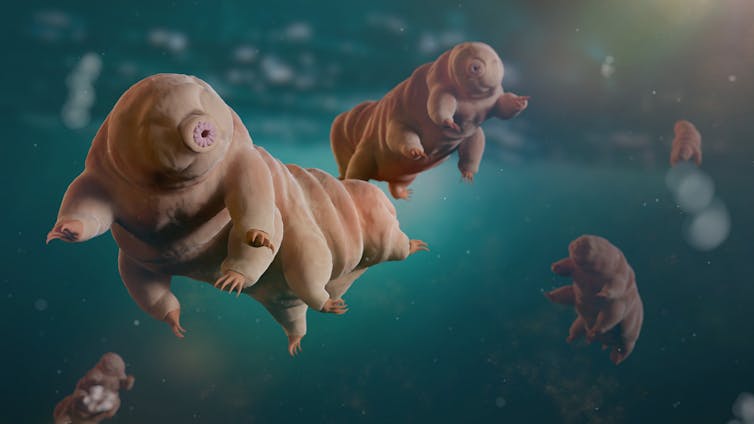
Tardigrades are incredibly resilient organisms. Dotted Yeti
We’ll need much more research if scientists are ever to get to this stage. However, in the past, several governments have been keen to enforce tight restrictions on how genome editing is used, as well as on other technologies for inserting genes from one species into another.
Germany and Canada are among the most cautious, but elsewhere restrictions seem to be relaxing.
In November 2018, the Chinese scientist He Jiankui announced that he had created the first gene edited babies. He had introduced a gene into the unborn twins that confers resistance to HIV infection.
The scientist was subsequently jailed. But he has since been released and allowed to carry out research again.
In the new space race, certain countries may go to lengths with genome editing that other nations, especially in the west where restrictions are already tight, may not. Whoever wins would reap enormous scientific and economic benefits.
If Rees and the other futurists are right, this field has the potential to advance our expansion into the cosmos. But society will need to agree to it.
It’s likely there will be opposition, because of the deep-seated fears of altering the human species forever. And with base and prime editing now having advanced the precision of targeted gene editing, it’s clear that the technology is moving faster than the conversation.
One country or another is likely to take the leap where others pull back from the brink. Only then will we find out just how viable these ideas really are. Until then, we can only speculate with curiosity, and perhaps excitement too.

Sam McKee, Associate Tutor and PhD Candidate in Philosophy of Science, Manchester Metropolitan University
This article is republished from The Conversation under a Creative Commons license. Read the original article.
The Conversation
July 29, 2024

Blue Moon
Using radar, a Nasa spacecraft, Lunar Reconnaissance Orbiter (LRO), has confirmed the existence of caves beneath the lunar surface. Here’s why such geological features will be key for establishing a base on the Moon, and what they can tell us about Earth and our Moon’s shared cosmological origins.
Lunar orbiting satellites first spotted pits on the Moon’s surface decades ago. Many of these were thought to be openings that connected to substantial underground tunnels that form through volcanic processes, but only now has this been confirmed through the analysis of radar data.
Some of the tunnels thought to exist on the Moon are expected to be lava tubes, which are also found on Earth. When molten lava flows out of the ground, the lava stream eventually cools and hardens into a crust. The lava inside is still molten, and continues to flow. Once the lava has flowed away, it leaves an empty tunnel called a lava tube. These formation processes are thought to be be very similar on the Earth and the Moon.
The data used in the latest study was collected in 2010 by LRO but only recently analysed using state of the art signal processing techniques. Radar (electromagnetic waves of 12.6cm wavelength) fired at acute angles towards these lunar pits, partially illuminated the shadowed subterranean areas to generate measurable radar echo signals.
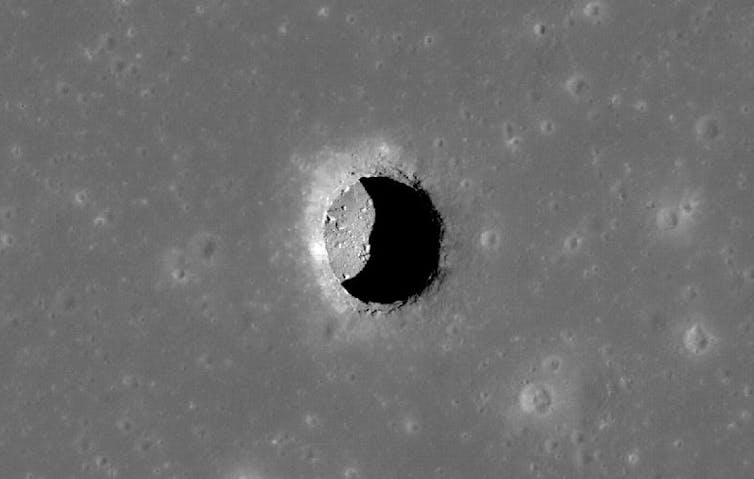
The pit in Mare Tranquillitatis leads to an underground cave system. Nasa
The timing and amplitude of the reflected signals allowed researchers to compare with simulations and build up a picture of the underground terrain. Data indicate that the largest “Mare Tranquillitatis” pit leads to a cave 80 metres long and 45 metres wide: an area equivalent to around half a football pitch.
It is likely that the lunar surface is home to hundreds of such caves. It is widely thought that around 4.5 billion years ago, a young Earth violently collided with a Mars-sized proto-planet, splitting our youthful planet into the Earth and Moon system we have today.
After this high energy impact, the Moon may have been molten. It is therefore hardly surprising that caves of seemingly volcanic origin, bearing striking similarities with volcanic caves here on Earth, are present on the Moon. However, we don’t need to worry about astronauts dealing with the dangers of a volcanic eruption; volcanic activity on the Moon petered out entirely around 50 million years ago.
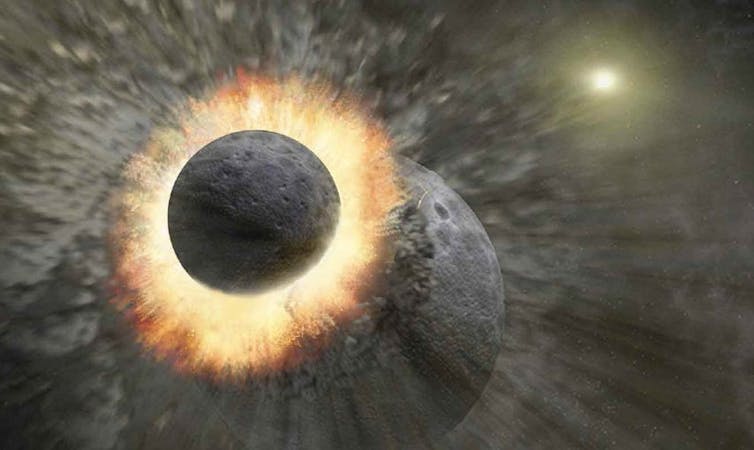
The Moon is thought to have formed when a Mars-sized object slammed into Earth. NASA/JPL-CALTECH/T. PYLE.
A home from home?
On Earth, we live in an unusually fortuitous environment, which protects us from threats from outer space. For example, Jupiter, the largest planet in our solar system, is well placed to gravitationally drag asteroids away from Earth. This minimises the frequency of cataclysmic asteroid collisions with our planet – such as the one that spelled the end of the dinosaurs.
One less obvious threat to life on Earth is ionizing radiation. The whole solar system is constantly bathed in a soup of charged particles called galactic cosmic rays, which are accelerated to huge speeds by distant supernova explosions, sending them on a collision course with Earth.
In addition, periodic events called coronal mass ejections from our own sun fling highly energetic particles in our direction in much larger numbers, but on a less frequent basis.
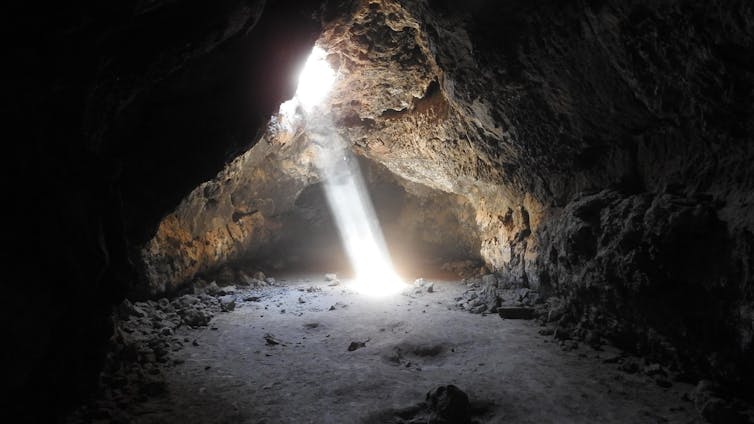
Lava tubes like this one may also exist on the Moon. NPS / B Michel
The Earth’s magnetic field protects us from this radiation to a large degree, by funneling the charged particles towards the north and south poles. This is the origin of aurora borealis and australis that light up the night sky at high latitudes. The Earth’s thick atmosphere also protects us, but we still get some exposure: a return transatlantic flight, where we are higher up in the atmosphere, gives the traveller a dose of radiation equivalent to five X-ray scans.
Now spare a thought for our Moon, which possesses neither an atmosphere nor notable magnetic field. Far from being a “sea of tranquility” (the name of the site of the first human landing on the Moon in 1969) the lunar surface is constantly bombarded by high energy radiation.
This poses a serious challenge for populating a Moon base with humans. Astronauts bouncing about on the lunar surface will soak up about 10 times more radiation than experienced on a transatlantic flight and about 200 times what we get on Earth’s surface.
Although our bodies can deal with the generally harmless low levels of background radiation we experience on Earth, exposure to high levels of ionising radiation can have serious health implications. When ionising radiation interacts with the body, it can ionise the atoms contained within cells, stripping them of electrons. This damage can sometimes prevent DNA from replicating properly, and in extreme cases, can cause cell death.
For these reasons, any Moon base must provide adequate radiation shielding to protect its inhabitants. However, radiation shielding is best provided by dense material, which is expensive to transport to the Moon from Earth.
Hence, naturally shielded areas, like the recently discovered caves, are being earmarked as possible locations for human habitation on the Moon. These caves would afford its residents a whopping 130 to 170 meters of solid rock shielding – enough to halt even the highest energy radiation.

Robin Smith, Senior Lecturer in Physics, Sheffield Hallam University
This article is republished from The Conversation under a Creative Commons license. Read the original article.
No comments:
Post a Comment